Pennines
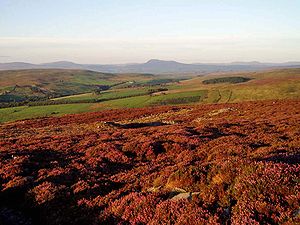
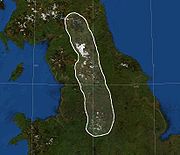
The Pennines are a mountain range reaching from the Peak District of Derbyshire northward to the Tyne Gap in Northumberland, beyond which rise the Cheviots. The Pennines form the watershed between the west and the east.
These fells are described as the Backbone of England".[1][2][3] A long more-or-less continuous chain, the Pennines include the Peak District (primarily in Derbyshire), then in Yorkshire they fill much of the western parts of the West Riding and North Riding, becoming the source of many of the becks which form the rivers which carve the great Yorkshire Dales and the dramatic Forest of Bowland. They form a substantial physical barrier between the towns of Yorkshire and Lancashire. The Pennines are separated from the Lakeland Fells of Cumberland and Westmorland by the Eden Valley but fill the eastern acres of both of those counties and much of County Durham.
The Cheviot Hills to the north are separated from the Pennines by the Tyne Gap and the Whin Sill, along which run the A69 and Hadrian's Wall though they are much of the same formation. We may though set the beginnings of the Pennines in the north at the Tyne Gap, where the North Tyne carves its valley through the Northumberland landscape, and in the south at the beginning of the Peak District in the Derbyshire Dales, or at the edge of Stoke-on-Trent in Staffordshire, about 40 miles south of Edale where walkers begin their Pennine trails.
Dales and rivers
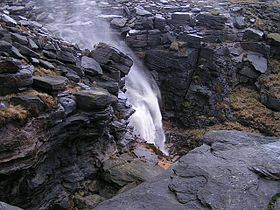
The Pennines are an important water catchment area with numerous reservoirs in the headwaters of the major river valleys. The region is widely considered to be one of the most scenic areas of the United Kingdom.[4] The North Pennines and Nidderdale have been declared an "Area of Outstanding Natural Beauty", while portions of the Pennines are incorporated into the Peak District National Park, the Yorkshire Dales National Park and the Northumberland National Park.[5] Britain's first long distance footpath, the Pennine Way, runs the full length of the Pennine chain and is 268 miles long.[6]
The Pennines stand at the head of each of the Yorkshire Dales and are the source of al the great rivers of northern England, including the Lancashire Calder and Yorkshire Calder, Eden, Mersey, Irwell, Ribble, Tees, Trent, Tyne and all the picturesque contributories of the Yorkshire Ouse which with the Trent ultimately make the mighty Humber.
Fells and dales
Highest peaks
The highest of the Pennine mountains is Cross Fell in Cumberland. The highest fells are:
- Cross Fell (Cumberland) 2,930 feet
- Mickle Fell (Yorkshire) 2,585 feet
- Whernside (Yorkshire) 2,415 feet
- Ingleborough (Yorkshire) 2,372 feet
- High Seat (Mallerstang, Yorkshire) 2,328 feet
- Wild Boar Fell (Mallerstang, Westmorland) 2,324 feet
- Pen-y-ghent (Yorkshire) 2,274 feet
- Kinder Scout (Derbyshire) 2,087 feet
Dales
- Airedale
- Calderdale
- Dovedale
- Nidderdale
- Ribblesdale
- Swaledale
- Teesdale
- Weardale
- Wensleydale
- Wharfedale
Pennine Way
The Pennine Way, Britain's longest, most famous long-distance footpath extends from Edale in Derbyshire into and across the Cheviots, ending at Kirk Yetholm in Roxburghshire. It winds for 267 miles over hill and dale, through 287 gates, over 249 timber stiles and 183 stone stiles, across 204 bridges, guided by 458 waymarks, from Derbyshire to Roxburghshire, and a typical walk the length of the way may take two and a half to three weeks.
Name of the Pennines
The name of the Pennines, the Backbone of Britain, is taken from that of the Appenines, the Backbone of Italy. It is not an ancient name, but the similarity of the two mountain ranges appealed to the classically educated. The first unqualified use of the name "Pennines" to describe the mountain range is found in the spurious book De Situ Britanniae, first published in 1757:[7]
This province is divided into two equal parts by a chain of mountains called the Pennine Alps, which rising on the confines of the Iceni and Carnabii, near the River Trivona (River Trent), extend towards the north in a continued series of fifty miles.
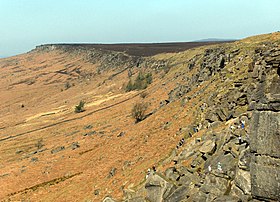
This book purported to contain the account of a Roman general preserved in the manuscript of a 14th-century English monk, Richard of Cirencester, and was considered the premier source of information on Roman Britain for more than a century after it was made available in 1749, though it was in fact a forgery created by Charles Bertram, a Briton then living in Copenhagen. In 1853, Arthur Hussey listed several names in De Situ Britanniae that he could not trace to an earlier source, including the "Pennine Alps".[8] However, by that time, particularly in the early 19th century, the name "Pennine Chain" or "Pennines" had become widely accepted.
Nevertheless, De Situ Britanniae was not entirely original in the matter. William Camden, the first at many things gave the name "our Appenine" in his Britannia. In the English version published in 1607 he writes under the entry for Staffordshire:
The North part riseth up and swelleth somewhat mountainous, with moores and hilles, but of no great bignesse, which beginning here, runs like as Apennine doth in Italie, through the midest of England with a continued ridge, rising more and more with divers tops and cliffs one after another even as far as Scotland, although oftentimes they change their name. For here they are called Mooreland, after a while the Peak, Blackstone Edge, then Craven, anon as they go further Stanmore, and at length being parted diversly, as it were, into hornes, Cheviot.
Also of the fells he writes:
Of these hils I have made mention the more willingly, both because they are the highest in our Appenine
Camden mentions the Appenines frequently, and asserts that their name is from Gaulish, equivalent to the Welsh pen for mountain peak, and which gives us the names of several of the fells in our Appenine, as Pen-y-ghent and Pendle Hill. Daniel Defoe, writing a hundred years later, writes of "the English Appenine", which name he attributes to Camden.
In his 2004 book Names and History: People, Places and Things, George Redmonds provided a modern assessment.[9] He comments at length on the strange omission of the etymology of "Pennines" in the serious literature and concludes that the origin of the name is De Situ Britanniae and that "nor do we know any name for the whole range before the 18th century."
Montgomery Martin, in the Illustrated Atlas and Modern History of the World, serialised up to 1851, refreed to the mountains as "the Cumberland hills, which have been termed the British Appenines". Camden's coinage was firmly embedded by then in the consciousness, if not apparently fully accepted until the High Victorian Age which was just beginning.
Place-names of the Pennine fells
The names of fells, dales and towns of the Pennines bear memories of several tribes which have held sway here; the Ancient Britons, the English and the Norse. For example the Old Welsh pen is found in the town of Penrith and fells such as Pen-y-ghent, and the old tongue too in the River Eden and the name of Cumberland itself. More commonly the local names result from the English and Norse settlements; in Yorkshire, Cumberland and Westmorland many Norse words not commonly used in standard English are part of everyday speech, as for example, gill (a narrow steep valley), beck (brook) and of course fell (hill).[10]
Geology and landscape
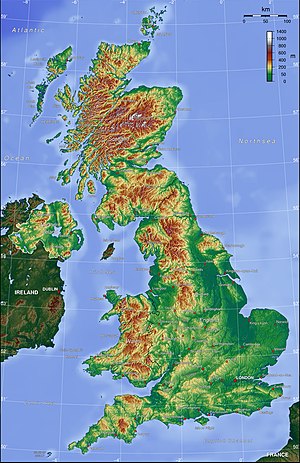
The Pennines have been carved from a series of geological structures whose overall form is that of a broad anticline whose axis extends in a north–south direction. The North Pennines are coincident with the Alston Block, whilst the Yorkshire Dales are coincident with the Askrigg Block. In the south the Peak District is essentially a flat-topped dome. Each of these structures consists of Carboniferous Limestone overlain with Millstone Grit.
The limestone is exposed at the surface to the north of the range, in the North Pennines AONB, and to the south in the Derbyshire Peak District. In the Yorkshire Dales the limestone exposure has led to the formation of large underground cave systems and watercourses, known as "gills" and "pots" in the Yorkshire dialect. These caves, or "potholes", are more prevalent on the eastern side and are amongst the largest in England; notable examples are the chasms of Gaping Gill, which is over 350 feet deep, and Rowten Pot, which is 365 feet deep. Erosion of the limestone has also led to some unusual geological formations in the region, such as the limestone pavements of the Yorkshire Pennines. Between the northern and southern areas of exposed limestone (between Skipton and the Peak District) lies a narrow belt of exposed gritstone. Here, the shales and sandstones of the Millstone Grit form high hills occupied by a moorland of bracken, peat, heather and coarse grasses[11], with the higher ground being uncultivable and barely fit for pastures.
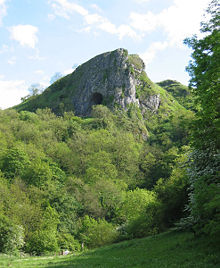
The landscape of the Pennines is characterised by upland areas of high moorland indented by more fertile river valleys.
Birds, beasts and plants
Flora in the Pennines is adapted to moorland and subarctic landscapes and climates. The flora found there can be found in other areas of moorland in Northern Europe and some species are also found in areas of tundra. Heather and bracken are notable in the Pennines amongst other plants. Deciduous trees are common, but conifers are also very common and have been widely planted as a cheap source of wood, especially around areas such as Kielder Forest.

The birds and beasts of the Pennines is typical of upland Britain, but there are some specialised species. Deer are found throughout the Pennines and many species of animals that are rare elsewhere in England can be found here. Arctic Hares, which were common in Britain during the Ice Age and retreated to the cooler, more tundra-like uplands once the climate warmed up, were introduced to the Dark Peak area of the Peak District in the 19th century.
Economy
The main economic activities include sheep farming, quarrying, finance and tourism.
Main towns and villages
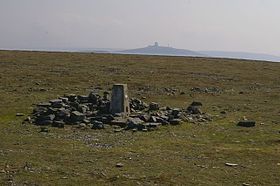
- Sheffield
- Buxton
- Hawes
- Keld
- Leek
- Muker
- Reeth
- Stanhope
- Thwaite
- Leeds
- Alston
- Bradford
- Halifax
- Huddersfield
References
- ↑ Poucher, W.A. (1946). The Backbone of England. A photographic and descriptive guide to the Pennine range from Derbyshire to Durham.. Guildford and Esher: Billing and Sons Limited.
- ↑ Edwards, W.; Trotter, F.M. (1975). The Pennines and Adjacent Areas. Handbooks on the Geology of Great Britain (Third ed.). London: HMSO (published 1954). p. 1. ISBN 0 11 880720 X.
- ↑ "Pennines -- Britannica Online Encyclopedia". http://www.britannica.com/eb/article-9059088/Pennines. Retrieved 2008-02-28.
- ↑ "Writer inspired by beauty of Pennines celebrates its views - Yorkshire Post". www.yorkshirepost.co.uk. http://www.yorkshirepost.co.uk/news/Writer-inspired-by-beauty-of.4564162.jp. Retrieved 2008-10-13.
- ↑ "Designated Landscapes Index". Natural England. http://www.countryside.gov.uk/LAR/Landscape/DL/index.asp. Retrieved 2007-12-02.
- ↑ "Trail stats, Pennine Way". National Trails Homepage. The Countryside Agency. http://www.nationaltrail.co.uk/PennineWay/text.asp?PageId=34. Retrieved 2007-08-03.
- ↑ Bertram, Charles (1757). "Chapter XXXIII". in Hatcher, Henry. The Description of Britain, Translated from Richard of Cirencester. London: J. White and Co. 1809. p. 51. http://books.google.com/books?id=OwJIAAAAMAAJ&pg=PA51
- ↑ Hussey, Arthur (1853). "A Renewed Examination of "Richard of Cirencester"". in Urban, Sylvanus. The Gentleman's Magazine. XXXIX. London: John Bowyer Nichols and Sons. pp. 270 – 273. http://books.google.com/books?id=DboUAAAAQAAJ&pg=PA272; discussing the so-called Iter VII: "... Alpes Peninos ..." not traced (to any earlier source).
- ↑ Redmonds, George (2007-03-15). Names and History: People, Places and Things. Hambledon & London (published 2004). pp. 65–68. ISBN 185285426X. http://books.google.com/?id=Qxk8qK2uF7kC&pg=PA65&dq=Pennines&q=Pennines A Major Place-Name Ignored
- ↑ Gunn, Peter (1984). The Yorkshire Dales. Landscape with Figures. London: Century Publishing Co Ltd. ISBN 0 7126 0370 0
- ↑ page 4 and page 5, Marginal Upland Grazing Sutton Moor, Domesday Reloaded, BBC 1986
- Arthur Raistrick, 'The Pennine Dales', Eyre Methuen Ltd 1968, ISBN 0-413-26760-1